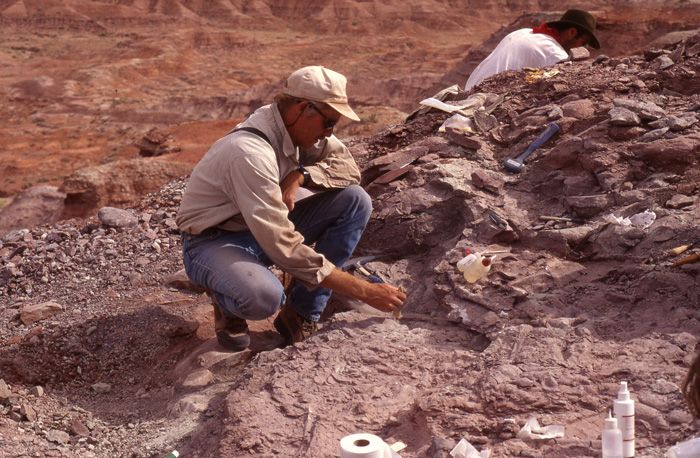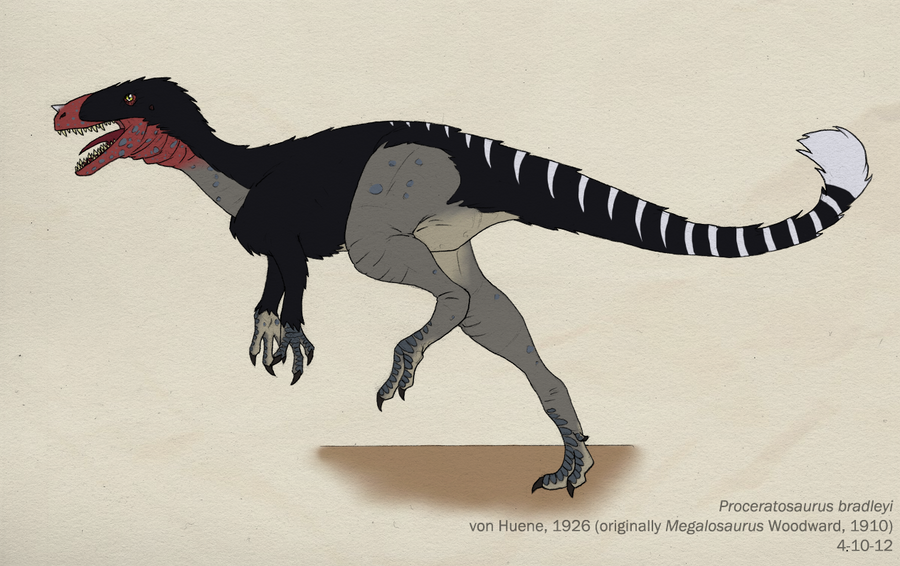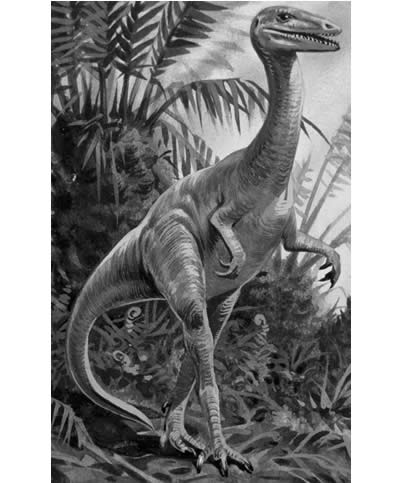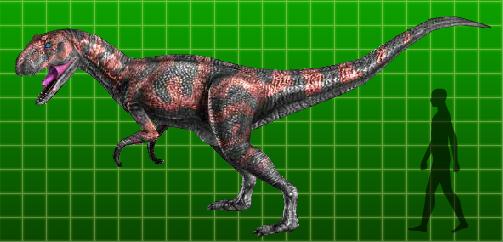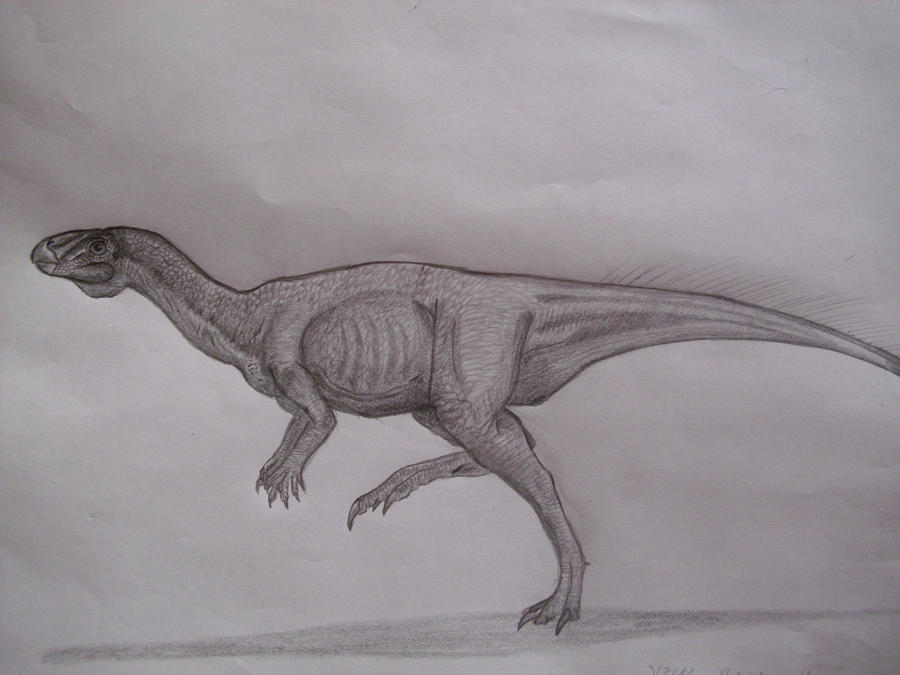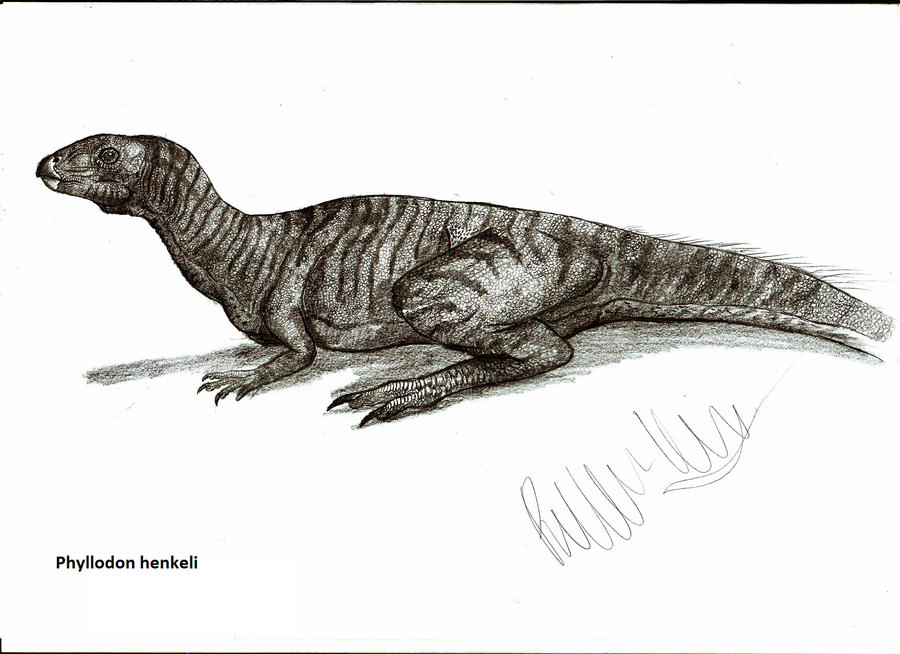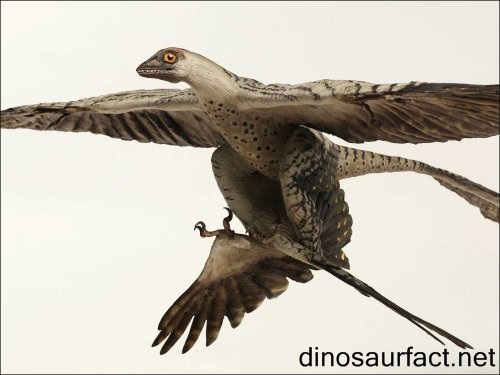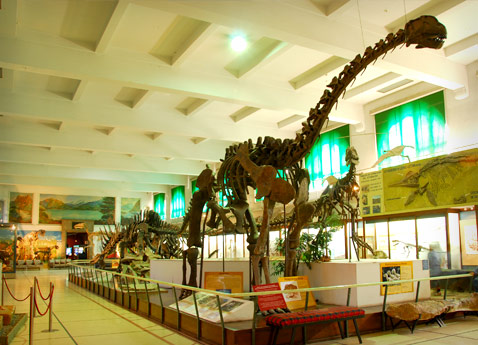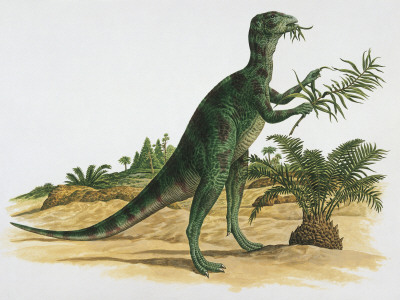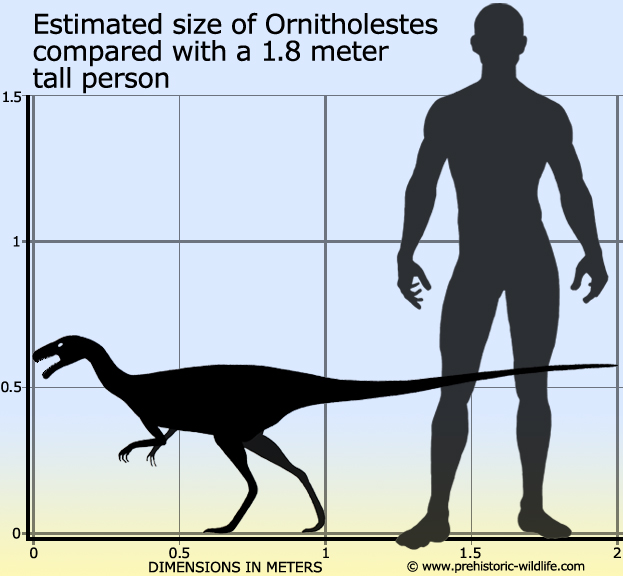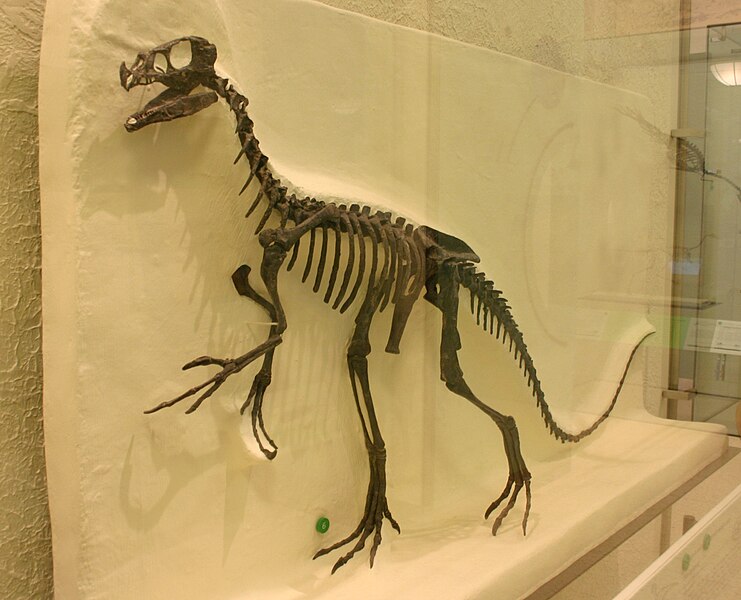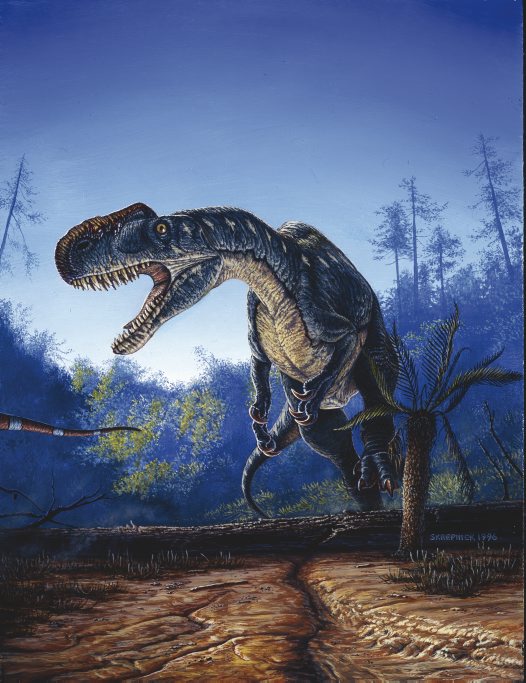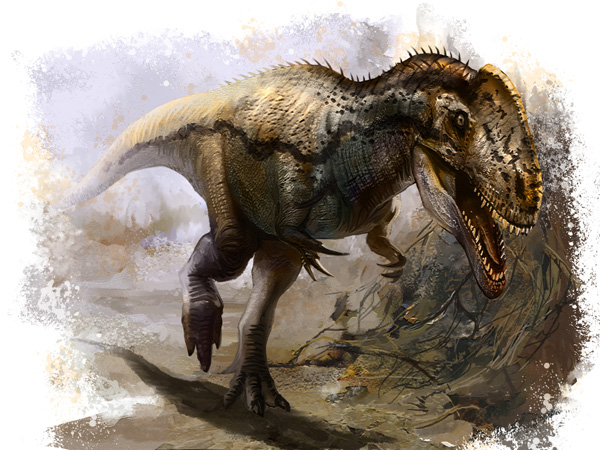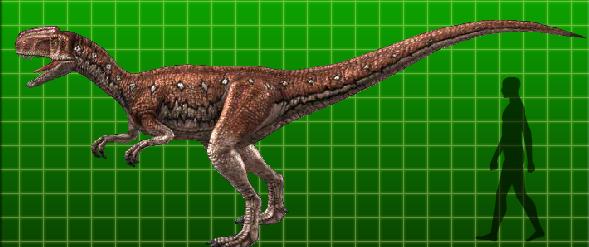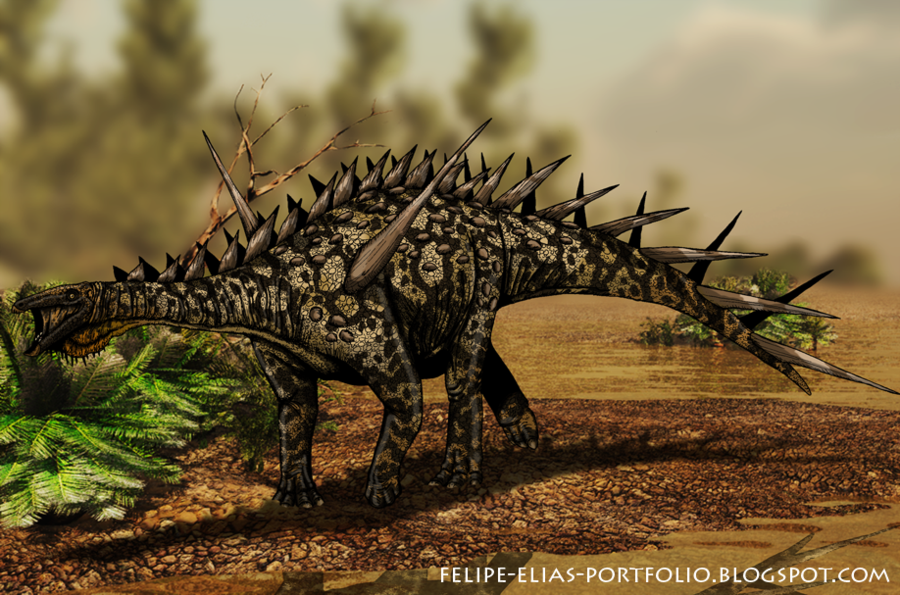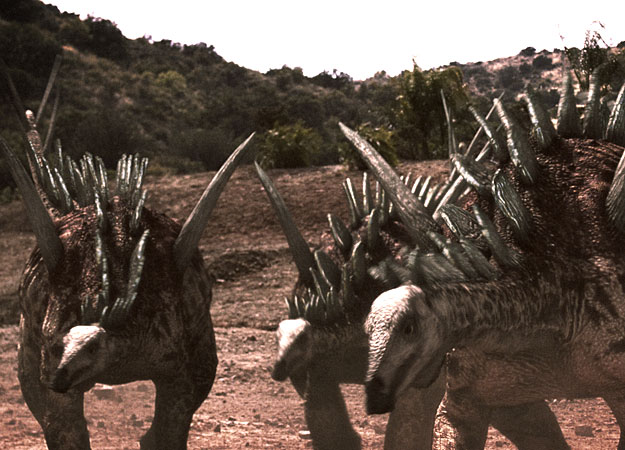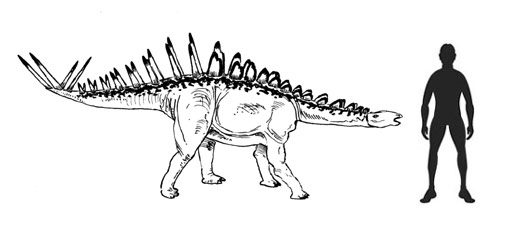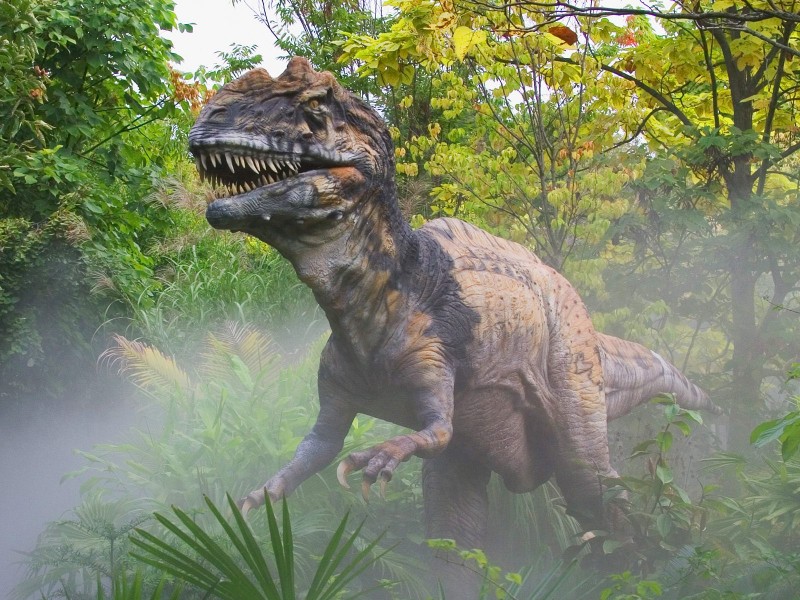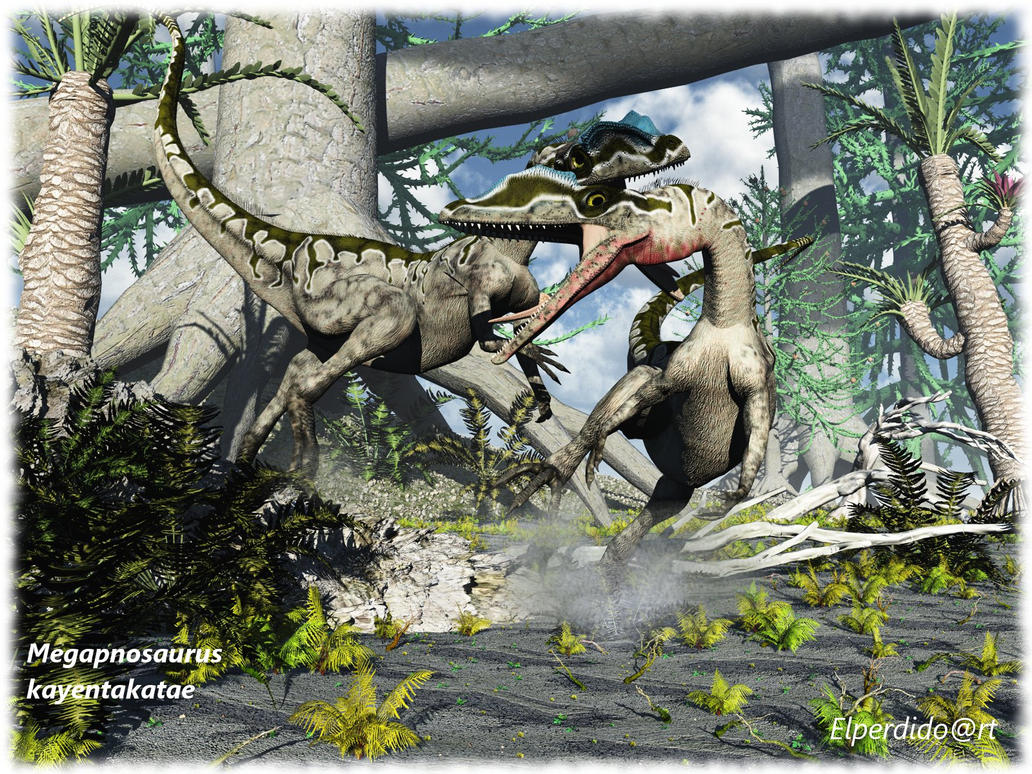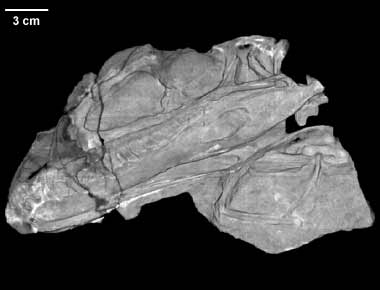[Recent Entries][Archive][Friends][User Info]
Below are 20 entries, after skipping 40 most recent ones in the "Сообщество, посвящённое ра" journal:[<< Previous 20 entries -- Next 20 entries >>]
| December 16th, 2012 | |
|---|---|
| 06:20 pm [industrialterro] [Link] |
Sarcosaurus Sarcosaurus (meaning "flesh lizard") is a genus of theropod dinosaur, either a coelophysoid or a basal ceratosaur, roughly 3.5 meters long. It lived during the Sinemurian stage of the Early Jurassic, about 194 million years ago. Fossils of Sarcosaurus were found in the Lower Lias of England. The type species, Sarcosaurus woodi, was first described by Charles William Andrews in 1921 shortly after a partial skeleton had been found by S.L. Wood near Barrow-on-Soar. The generic name is derived from Greek sarx, "flesh". The specific name honours Wood. The holotype, BMNH 4840/1, consists of a pelvis, a vertebra and the upper part of a femur. The preserved length of the femur is 31.5 centimetres. A second species, Sarcosaurus andrewsi, was named by Friedrich von Huene in 1932, based on a 445 millimetres long tibia, BMNH R3542, described by Arthur Smith Woodward in 1908 and found near Wilmcote. Confusingly von Huene in the same publication named the very same fossil Magnosaurus woodwardi. Later he made a choice for S. andrewsi to be the valid name. In 1974 S. andrewsi was reclassified as Megalosaurus andrewsi by Michael Waldman, on the probably erroneous assumption it was a megalosaurid. A later study concluded the two species to be indistinguishable except for size, but other authors consider any identity to be unprovable as there are no comparable remains and conclude both species to lack autapomorphies and therefore to be nomina dubia. Von Huene in 1932 referred a partial skeleton from the collection of the Warwick Museum to S. woodi but the identity is unproven; in 1995 it was given the generic name "Liassaurus" but this has remained a nomen nudum. Andrews originally assigned Sarcosaurus to the Megalosauridae. The first to suggest a more basal position was Samuel Paul Welles who placed it in the Coelophysidae. Later analyses resulted in either a position in the Ceratosauria, or in the Coelophysoidea.
Репродукции (1, 2):
Размеры тела в сравнении с человеком:
Tags: Вымершие рептилии, Юра, авеметатарзалии, архозавроморфы, архозавры, диапсиды, динозавроморфы, динозавры, тероподы, ящеротазовые |
| December 15th, 2012 | |
| 03:39 pm [industrialterro] [Link] |
Sarahsaurus Sarahsaurus — монотипный род травоядных динозавров из группы Sauropodomorpha, живших в начале юрского периода на территории нынешнего штата Аризона, США. Типовый вид — Sarahsaurus aurifontanalis. В 1997 году команда палеонтологов под руководством Тимоти Роу установила, что, найденные при раскопках в Голд Спринг, штат Аризона, ископаемые принадлежат к ранее неизвестному виду динозавров. Вид был назван и описан в 2010 году Timothy Rowe, Robert R. Reisz и Hans-Dieter Sues. Название рода дано в честь Сары Батлер, которая финансировала раскопки. Видовое название происходит от латинского aurum — «золото» и fontanalis — «источник». Голотип, ТММ 43646-2 состоит из довольно полного скелета с черепом. Второй скелет без черепа, найденный в этой же местности, имеет обозначение ТММ 43646-3. Третий скелет - MCZ 8893, череп которого находится в коллекции Музея сравнительной зоологии (Museum of Comparative Zoology) Гарвардского университета. Sarahsaurus является относительно небольшим базальным зауроподоморфом, в длину достигавшим 4,2 м и весившим около 113 килограммов. Sarahsaurus имеет довольно широкую и плоскую голову, длинную шею, длинный хвост, «сильные» передние и небольшие задние конечности. Имел четыре зуба в премаксилле и двадцать на зубной кости. Также найдены четырнадцать шейных позвонков, три крестцовых позвонка и около пятидесяти хвостовых позвонков. Динозавр имел огромный коготь на большом пальце. Проведенные кладистические анализы не дали однозначного ответа о положении Sarahsaurus на эволюционном дереве. Во всяком случае, Sarahsaurus находится на вершине генеалогическое дерева динозавров. По результатам одного из анализов, который основан на исследованиях Ятса в 2007 году, авторы утверждают, что Sarahsaurus является более базальным таксоном завроподоморф, чем другие ранние североамериканские завроподоморфы — Anchisaurus и Seitaad. В свою очередь, в результате другого анализа, данный динозавр был отнесён к базальным завроподам, которые были более эволюционно продвинуты, чем Anchisaurus и Seitaad. По мнению авторов этой гипотезы, она является более правдоподобной, так как Sarahsaurus на 40 миллионов лет моложе, чем самый старый известный завроподоморф. Ни в одном из этих исследований Sarahsaurus не был тесно связан с Anchisaurus и Seitaad, в результате чего ученые предполагают, что эти три таксона в Северной Америке развивались самостоятельно. Ученые предполагают, что Sarahsaurus имел очень сильные передние конечности с когтями для выкапывания корней растений. Прямые кости бедер ученые объясняют адаптацией к весу тела. In a cladistic analysis, presented by Apaldetti and colleagues in November 2011, Sarahsaurus was found to be most closely related to Ignavusaurus within Massopoda.
Tags: Вымершие рептилии, Юра, авеметатарзалии, архозавроморфы, архозавры, диапсиды, динозавроморфы, динозавры, завроподоморфы, прозавроподы, ящеротазовые |
| 03:27 pm [industrialterro] [Link] |
Saltriosaurus Saltriosaurus (Saltrio-lizard) is the informal name for a theropod dinosaur that lived during the Jurassic period. It was found in 1996, when Angelo Zanella discovered its remains in a quarry in Saltrio, in northern Italy. Very little is known about the dinosaur. The name "Saltriosaurus", given to it in 2000 by Cristiano Dal Sasso, is a nomen nudum. Saltriosaurus is thought to have resembled Allosaurus, and is the oldest known three-fingered dinosaur. Like Allosaurus, it appears to have been carnivorous and is estimated to have weighed about 500 kilograms (1,100 lb). It was 8 meters (26 ft) long and 4 meters (13 ft) tall, with a skull 70 centimeters (28 in) long. The single tooth that has been found was about 7 centimeters (2.8 in) long. About ten percent of the skeleton has been discovered thus far: lateral tooth, dorsal rib fragments, scapular fragment, furcula, humeri, metacarpal II, phalanx II-1, phalanx III-1, phalanx III-2, manual ungual III, proximal fibula, distal tarsal III, distal tarsal IV.
Tags: Вымершие рептилии, Юра, авеметатарзалии, аллозавриды, архозавроморфы, архозавры, диапсиды, динозавроморфы, динозавры, карнозавры, тероподы, ящеротазовые |
| 02:26 pm [industrialterro] [Link] |
Proceratosaurus Процератозавр (Proceratosaurus - букв. «до цератозавра») — род небольших (около 3 метров в длину) хищных ящеротазовых динозавров из семейства процератозавридов, живших в средней юре (батониан) около 167.7 - 164.7 миллионов лет назад на территории современной Англии. Изначально считался предком цератозавров (отсюда и название), в связи с аналогичным малым гребнем на его морде. Сейчас, однако, считается целурозавром, один из самых ранних известных науке, входит в надсемейство тиранозавров. Артур Смит Вудворд, который изучал процератозавра, первоначально считал его предком позднеюрского цератозавра, из-за сходства их носовых гребней. Позже исследование в 1930 году Фридриха фон Хайна позволили отнести его к группе целурозавров. До конца 1980-х годов после исследований было выявлено, что процератозавр является более примитывным тероподом, чем целурозавры, и классификацию процератозавра было решено снова пересмотреть. Грегори С. Пол предложил, что он является близким родственником орнитолеста, опять же в основном из-за гребня на носу (хотя мысль, что орнитолест рождался с носовым гребенем позже была опровергнута). Пол рассматривал процератозавра и орнитолеста, как тероподов, не относящихся ни к цератозаврам, ни к целурозаврам, и относил их к примитивным аллозаврам. Кроме того, Пол считал что динозавр Piveteausaurus относится к тому же роду, что и Proceratosaurus. Наличие на морде процератозавра маленького, как у цератозавра, рога позволило предположить, что между ними имеются родственные связи. Возможно, процератозавр питался наземными животными. Его зубы могли удерживать и скользкую рыбу. Свирепому хищнику процератозавру приходилось опасаться мегалозавра, который был в два раза крупнее и мог легко с ним справиться. Продолжительное время процератозавра относили к карнозаврам. Но, в отличие от них, его череп был мельче в тыльной верхней части. Теперь процератозавр считается ранним представителем группы целурозавров. Эта группа тероподов близких к птицам. Окаменелости динозавра были найдены около города Minchinhampton в графстве Глостершир, Англия. В длину взрослые особи процератозавра могли достигать до 3 метров, а весили около 150 килограмм. Длина черепа достигала около 30 см, что значительно меньше другого представителя семейства — килеска. Several phylogenetic studies in the early 21st century finally found Proceratosaurus (as well as Ornitholestes) to be a coelurosaur, only distantly related to the ceratosaurids and allosauroids, though one opinion published in 2000 considered Proceratosaurus a ceratosaurid without presenting supporting evidence. Phylogenetic analyses by Thomas R. Holtz, Jr. in 2004 also placed Proceratosaurus among the coelurosaurs, though with only weak support, and again found an (also weakly supported) close relationship with Ornitholestes. The first major re-evaluation of Proceratosaurus and its relationships was published in 2010 by Oliver Rauhut and colleagues. Their study concluded that Proceratosaurus was in fact a coelurosaur, and moreover a tyrannosauroid, a member of the lineage leading to the giant tyrannosaurs of the Late Cretaceous. Furthermore, they found that Proceratosaurus was most closely related to the Chinese tyrannosauroid Guanlong. They named the clade containing these two dinosaurs the Proceratosauridae, defined as all theropods closer to Proceratosaurus than to Tyrannosaurus, Allosaurus, Compsognathus, Coelurus, Ornithomimus, or Deinonychus. Этот динозавр был впервые изучен известным британским палеонтологом сэром Артуром Смитом Вудвордом в 1910 году, но он идентифицировал окаменелости как принадлежащие мегалозавру. Немецкий эксперт по динозаврам Фридрих фон Хюне столь же ошибочно приписал его к линии цератозавров, когда изучал черен пятнадцатью годами позже. Еще один экземпляр животного, которое могло быть представителем того же рода, был найден во Франции в 1923 году. Процератозавр известен только по фрагментам черепа, на котором видна основа рога на носу. Это привело фон Хюне к предположению о том, что речь идет о предке более позднего рогатого цератозара. Хотя черепной материал для изучения весьма скуден, он явно свидетельствует о том, что это карнозавр, а не цератозавр. Последние исследования показали, что процератозавр является базальным целурозавром, а также одним из древнейших предков тираннозавров.
Размеры тела в сравнении с человеком:
Tags: Вымершие рептилии, Юра, авеметатарзалии, архозавроморфы, архозавры, диапсиды, динозавроморфы, динозавры, процератозавриды, тероподы, тираннозавроиды, целурозавры, ящеротазовые |
| November 11th, 2012 | |
| 06:12 pm [industrialterro] [Link] |
Poekilopleuron Poekilopleuron (meaning 'varied ribs') is an extinct genus of large basal tetanuran theropod dinosaur, perhaps belonging to the clade Allosauroidea. It measured 9 metres (30 feet) long and 1 ton (1 tonne) in mass. It dates from the Bathonian (Middle Jurassic), 168 to 165 million years ago. Poekilopleuron is known from a partial skeleton discovered by Jacques Amand Eudes-Deslongchamps in July 1835 near La Maladrerie in Normandy, France, in a layer of the Calcaire de Caen Formation. This skeleton, part of the collection of the Musée de la Facultée des Sciences de Caen, was in 1944 destroyed during the Battle of Caen in World War II, and the taxon has since had to be studied on the basis of cast replicas. One set is present in the Muséum National d'Histoire Naturelle in Paris with inventory number MNHN 1897-2, a second in the Yale Peabody Museum, YPM 4938. The remains consisted of caudal vertebrae, cervical ribs, ribs, gastralia or belly ribs, a forelimb and a hindlimb. Eudes-Deslongchamps named the type species Poekilopleuron bucklandii in 1837 or 1838. The generic name is derived from Greek poikilos, "varied", and pleuron, "rib", a reference to the three types of rib present. The specific name, honouring William Buckland, was deliberately identical to that of Megalosaurus bucklandii. Eudes-Deslongchamps thought the specimen might well be proven to belong to this earlier named species; if so, merely the generic name would have to be changed. Indeed, following 1879 Poekilopleuron was often subsumed under Megalosaurus bucklandii. Eudes-Deslongchamps' choice caused problems however, when Friedrich von Huene in 1923 concluded it was part of Megalosaurus but as a separate species within that genus. As both species carried the same epithet bucklandii, they could no longer be distinguished. Von Huene therefore renamed the species into Megalosaurus poekilopleuron. Most later authors continued using the generic name Poekilopleuron. Another problem was caused by the fact that the name was only partially Latinised. In correct Greek it would have been "poikilopleuron", in Latin "poecilopleurum". This induced later writers to improve the spelling, leading to such variants as Poecilopleuron and Poikilopleuron (still used as late as 2006). However, the original name has priority and is valid. Five other species would be named in the genus. In 1869 Edward Drinker Cope renamed Laelaps gallicus into Poekilopleuron gallicum. In 1870 Joseph Leidy created a Poicilopleuron valens based on a fossil probably belonging to Allosaurus. In 1876 Richard Owen named a Poikilopleuron pusillus, in 1879 renamed by Cope to Poekilopleuron minor; in 1887 Harry Govier Seeley made it a separate genus: Aristosuchus. In 1883 W.A. Kiprijanow created a Poekilopleuron schmidti, of which the specific name honours Friedrich Schmidt, based on some indeterminate ribs and a sauropod metatarsal. This chimaera is a nomen dubium. A much later named species is Poekilopleuron valesdunensis created by Ronan Allain in 2002. In 2005 it was renamed Dubreuillosaurus. The most distinctive feature of Poekilopleuron were its forelimbs. Their length, about 60 cm, was a sign of this theropod's more original build. Unlike later Theropoda, whose forelimbs tended toward reduction in length in proportion to the animals' size, Poekilopleuron's were long and, by implication, potent. The length mostly resided in the elongated but powerfully muscled humerus. The antebrachia (forearms) were markedly short and robust, a characteristic shared with Poekilopleuron's slightly later and considerably larger American cousin Torvosaurus. A unique feature is a lack of the olecranon process on the ulna. The fossil of Poekilopleuron showed a rare complete set of gastralia: fourteen pair of belly ribs supported the body of the animal. Because the original fossil was destroyed and no other remains of Poekilopleuron have since been found, and also because of its name change, there is much controversy surrounding its classification that cannot be resolved. Traditionally it has been assigned to the Megalosauridae, but some recent analyses showed a position in the Sinraptoridae; others had as result it was a member of Megalosauroidea, in a basal position or in the Eustreptospondylinae. Benson et al. (2010) found it and Lourinhanosaurus to belong to Sinraptoridae. The material of Poekilopleuron bucklandii includes two tail vertebrae with the chevron of one vertebra ankylosed to the centrum of the next within the development of an exostosis. Two phalanges also preserve pathologies. One probable pedal phalanx shows three low, irregular exostosis-like projections. A second probable manual phalanx exhibits a "low rounded projection resembling a callus." Ralph Molnar considered the occurrence of three pathologies in one individual to be "noteworthy". Sadly the specimens cannot be examined further to determine the etiology of the pathologies because of their destruction during the British bombing raid in 1944.
Размеры тела в сравнении с человеком:
Tags: Вымершие рептилии, Юра, авеметатарзалии, архозавроморфы, архозавры, диапсиды, динозавроморфы, динозавры, карнозавры, синрапториды, тероподы, ящеротазовые |
| 05:50 pm [industrialterro] [Link] |
Podokesaurus Podokesaurus ("swift-footed lizard") was a small carnivorous dinosaur of the Early Jurassic Period (originally thought to be Late Triassic), and as such is one of the earliest known dinosaurs to inhabit the eastern United States. The small, bipedal carnivore was about 90 cm (3 ft) long and 0.3 m (1 ft) tall. It has been estimated that it could run at 14 – 19 km/h (9 - 12 mph), hence the name. Some researchers believe that it is related to, or identical with the Triassic genus Coelophysis. The only fossil of the type species Podokesaurus holyokensis, the full species name, was recovered in 1910 by Mount Holyoke College professor of geology and geography, Mignon Talbot. It consisted of a split boulder found by Talbot and her sister Elly on a hillock near to the college. The hillock consists of material deposited by ice and having its probable origin in the Portland Formation. The slab and counterslab showed a poorly preserved, incomplete skeleton. Most of the skull is lacking. Talbot made pictures of the stones and sought advise from Richard Swann Lull, an authoritative dinosaur expert. It was formally described in June 1911 by Talbot herself, who thereby became the first woman to name a non-avian dinosaur. The generic name is derived from Greek podokes, "swift-footed", an epitheton often used by Homer in the Ilias to describe the hero Achilles. The specific name refers to Holyoke. In 1958 a second specimen, BSNH 13656 (now on display at the Boston Museum of Science and given the number MOS 2001.248), was referred to the species by Edwin Harris Colbert and Donald Baird. It consists of natural casts in sandstone of a pubis, tibia, three ribs, and a possible vertebra, and indicates an individual about three times longer. The type specimen, therefore, might have been a juvenile. Because of the poor preservation it is hard to find any difference between the remains of Podokesaurus and those of the much better known Coelophysis. From this Colbert concluded in 1964 that Podokesaurus was not a distinct genus but in fact a species of Coelophysis: Coelophysis holyokensis. If so, it would by implication be a member of the Coelophysidae. However, the name Podokesaurus is still commonly used to refer to the material, while being assigned to a more general Coelophysoidea, as the identity is hard to prove and Coelophysis dates from a different period. The matter is complicated because all the original fossil material of Podokesaurus holyokensis was destroyed in a fire in the early twenties, and only casts remain, including those in the Division of Paleontology at the American Museum of Natural History in New York, the Peabody Museum of Natural History at Yale University, and the Amherst College Museum of Natural History (now the Beneski Museum).
Tags: Вымершие рептилии, Юра, авеметатарзалии, архозавроморфы, архозавры, диапсиды, динозавроморфы, динозавры, тероподы, целофизиды, ящеротазовые |
| 05:34 pm [industrialterro] [Link] |
Piveteausaurus Piveteausaurus (meaning "Jean Piveteau's lizard") is a genus of theropod dinosaur known from a partial skull discovered in the Middle Jurassic Marnes de Dives formation of Calvados, in northern France. The partial braincase that became the type specimen of Piveteausaurus was first described in 1923 by French paleontologist Jean Piveteau in illustrations and photographs of the specimen (MNHN 1920-7). The braincase is comparable in size to that of a large Allosaurus, and resembles that of another megalosauroid, Piatnitzkysaurus from Argentina. Piveteau grouped this partial skull with other specimens found earlier in that locality and described in 1808 by French naturalist Georges Cuvier. In 1861 English paleontologist Richard Owen assigned the fragments to the species Streptospondylus cuvieri, and Piveteau included the skull he found in the same species. MNHN 1920-7 was found by local collector Dutacq in rocks thought to be Oxfordian (Upper Jurassic), of the Vaches Noires cliffs near Dives in Normandy, France, and was after being reported by amateur geologist Cazenave in 1920 acquired by Professor Marcellin Boule for the Muséum national d'histoire naturelle. Later these rocks were reevaluated as older (Upper Callovian, Middle Jurassic, ~161 million years old). MNHN 1920-7 was reevaluated in 1964 by Alick Walker as part of his work on Ornithosuchus and the evolution of the Carnosauria. He assigned MNHN 1920-7 to Eustreptospondylus as the holotype, or type specimen, of the new species E. divesensis. The other bone fragments described by Cuvier and attributed to S. cuvieri by Owen were also transferred, as a "matter of convenience," but without conviction on the part of Walker, to the new species, E. divesensis. It was given its own genus in 1977 by Philippe Taquet and Samuel Welles: Piveteausaurus, named after Piveteau. Taquet and Welles removed the postcranial bones, conveniently associated with the skull by Walker, from the species. Later the braincase would be regarded by Gregory S. Paul as a species of Proceratosaurus (P. divesensis), but this assignment was rejected by other researchers. While the braincase appears to be distinct, the limited remains mean Piveteausaurus has not been easy to classify. It has been compared to Ceratosaurus, Eustreptospondylus, and Proceratosaurus, and was interpreted as a species of the latter two genera at various times. Piveteausaurus was originally regarded as a megalosaurid as a "matter of convenience", as its describers did not want to name a new family for such fragmentary remains. Tom Holtz and colleagues (2004) considered it to be an indeterminate member of Tetanurae, though they did not include it in a phylogenetic analysis. The first such analysis was performed by Benson in 2010. He found that while its exact placement was unresolved, it always grouped with a member of the clade Megalosauridae, and so most likely belonged to that family.
Tags: Вымершие рептилии, Юра, авеметатарзалии, архозавроморфы, архозавры, диапсиды, динозавроморфы, динозавры, мегалозавриды, тероподы, ящеротазовые |
| 05:10 pm [industrialterro] [Link] |
Piatnitzkysaurus Piatnitzkysaurus (named to honor Alejandro Mateievich Piatnitzky (1879-1959), Russian-born Argentine geologist) is a genus of theropod dinosaur. It is known from the Canadon Asfalto Formation, Middle Jurassic (Callovian stage) of what is now Argentina. Once thought to be a basal carnosaur, it may instead be a megalosauroid. Partial skeletons are known (two fractured skulls and parts of the postcranial skeleton) and show Piatnitzkysaurus was a lightly built medium-sized bipedal carnivore with robust arms around 4.3 metres (14 ft) long and around 450 kilograms (990 lb) in mass, though such estimates apply to the holotype, which is a subadult. Its ischium is 423 millimetres (16.7 in) long. Its braincase resembles that of another megalosauroid, the megalosaurid Piveteausaurus from France. The type species, Piatnitzkysaurus floresi, was described by Jose Bonaparte in 1979.
Размеры тела в сравнении с человеком (гипотетическая взрослая особь):
Ископаемые останки и реплики (1, 2, 3, 4, 5):
Tags: Вымершие рептилии, Юра, авеметатарзалии, архозавроморфы, архозавры, диапсиды, динозавроморфы, динозавры, мегалозавриды, тероподы, ящеротазовые |
| 05:02 pm [industrialterro] [Link] |
Phyllodon Phyllodon henkeli — вид травоядных птицетазовых динозавров, принадлежащих к группе Euornithopoda, живших в конце юрского периода в районе нынешней Португалии. В 1973—1975 годах Ричард Талборн описал и назвал данного динозавра на основе ископаемого зуба, найденного в шестидесятые годы Зигфридом Хенкелем на территории округа Лейрия, как типовой вид Phyllodon henkeli.Название рода происходит от древнегреческого φυλλον, phyllon — «лист» и ὀδών, odon — «зуб». Обозначение вида дано в честь первооткрывателя. Голотип, MGSP G5, была найден в слоях фомации Guimarato, относящихся к киммериджу. Он состоит из фрагментов зубов и челюсти. Из-за фрагментарного характера останков Phyllodon помечен как nomen dubium. Oliver Rauhut, однако, отмечает, что эти зубы не редки в формации и с XVIII века встречаются довольно часто. По Ричарду Талюорну вид Phyllodon henkeli отнесен в семейство Hypsilophodontidae. Эта группа в настоящее время рассматриваются как парафилетическая (неестественная), и поэтому вид причесляют к группе Euornithopoda.
Tags: Вымершие рептилии, Юра, авеметатарзалии, архозавроморфы, архозавры, диапсиды, динозавроморфы, динозавры, неорнитискии, птицетазовые |
| 03:10 pm [industrialterro] [Link] |
Pedopenna Педопенна (Pedopenna от pes — «нога» и penna — «перо, крыло») — род мелких оперенных динозавров из отложений Даохугоу в Китае. Нельзя исключить того, что он древнее археоптерикса, хотя датировка отложений Даохугоу остается спорной. Некоторые подсчеты дают раннемеловой возраст (барремиан, около 140,2—145,5 млн. лет назад), но последние радиометрические датировки указывают на середину юры (келловей, около 164-161 млн. лет назад). В настоящее время датировка формирования является спорной и определяется между 168—140 млн лет назад. Свое родовое название Pedopenna получила из-за длинных контурных перьев на метатарзусе; видовое название daohugouensis связано с названием местонахождения, в котором был обнаружен голотип. Возможный прижизненный размер Pedopenna daohugouensis составлял около 1 м или менее в длину, но поскольку этот вид известен только по задним ногам, действительную длину определить трудно. Педопенну рассматривают как близкого к птицам динозавра из группы Paraves, включающей птиц и их ближайших родственников среди манирапторов. Ноги педопенны напоминают таковые родственных ей троодонтид и дромеозаврид (которые вместе образуют группу дейнонихозавров), но в целом более примитивны. В частности, второй палец Pedopenna не столь специализирован, как у дейнонихозавров. Хотя он слегка укорочен и имеет увеличенный коготь, он не столь сильно развит и искривлен, как серповидные когти ее родственников. Авторы описания, придерживающиеся мнения о средне или верхне-юрском возрасте отложений Даохугоу, считают, что обнаружение на территории современного Китая примитивного родственника птиц наряду с находками других птицеподобных динозавров может свидетельствовать о том, что предки птиц обитали в Азии. Сходство педопенны с птицами представляет собой еще одно доказательство близости динозавров и птиц. Помимо того, что скелет задних конечностей весьма сходен с таковым птиц, педопенна замечательна наличием длинных контурных перьев на метатарзусе. У некоторых дейнонихозавров также обнаружены «ножные крылья», но у педопенны они отличаются от подобных структур у микрораптора и ему подобных. «Ножные крылья» педопенны меньше и имеют округленную форму. Самые длинные перья слегка короче метатарзуса и не превышают 5,5 см в длину. Кроме того, перья педопенны были симметричными, в отличие от асимметричных перьев некоторых дейнонихозавров и птиц. Поскольку асимметричные перья типичны для животных, приспособленных к полету, весьма вероятно, что перья педопенны представляет собой раннюю стадию в эволюции этих структур. Несмотря на то, что многие из отпечатков перьев довольно слабые, ясно видно, что каждое имело рахис и бородки. Хотя точное число ножных перьев не известно, их было больше, чем на «задних» крыльях микрораптора. У педопенны также видны более короткие перья, перекрывающие основания более длинных ножных перьев, что доказывает существование кроющих перьев, как у современных птиц. То, что перья педопенны имеют меньшее количество аэродинамических адаптаций, чем перья задних крыльев микропраптора, и, по видимому, были менее плотными подсказывает, что, если они и выполняли аэродинамическую функцию, то существенно менее успешно, чем у дейнонихозавров и птиц. Сюй С. и Чжан Ф. в описании Pedopenna предположили, что ее перья могли служить лишь украшением или даже находиться в стадии редукции. Возможно, задние крылья имелись у предков дейнонихозавров и птиц, и позже были утрачены в линии, ведущей к птицам. В таком случае педопенна может представлять собой промежуточную стадию, когда задние крылья находятся в процессе редукции от вполне функционального аппарата, предназначенного для планирования, до чисто демонстративной или изолирующей функции.
Tags: Вымершие рептилии, Юра, авеметатарзалии, архозавроморфы, архозавры, дейнонихозавры, диапсиды, динозавроморфы, динозавры, манирапторы, тероподы, целурозавры, ящеротазовые |
| 02:45 pm [industrialterro] [Link] |
Patagosaurus Patagosaurus (meaning "Patagonian lizard") was a large herbivorous dinosaur from the long-necked group Sauropoda. It reached a length of 18 meters. Similar to other primitive eusauropods, it was rather heavily built and similar to Cetiosaurus in general appearance. It is known from a dozen individuals, though some referred material may belong to another related dinosaur genus. It lived during the Callovian of the Middle Jurassic (163-161 mya) in what is now Argentina. Other Argentinian dinosaurs living approximately at the same time were Piatnitzkysaurus, Condorraptor and Amygdalodon. It was described by Jose Bonaparte in 1979. The type species is P. fariasi. Some authors (such as Bonaparte and Upchurch) have placed Patagosaurus in the family Cetiosauridae, but not all paleontologists agree; sauropod classifications are still uncertain. Шея у патагозавра, хоть и довольно короткая для завропода, все же была длиннее чем у других групп динозавров. Патагозавр, например, мог питаться листвой и побегами с веток, находившихся на высоте 5-6 метров от земли. Целый череп патагозавра пока не найден, но, судя по нескольким отдельным костям, патагозавр был высоким жмвотным, с не слишком длинным телом, а его челюсти содержали ряд широких, плоских зубов. Ноздри патагозавра, по сравнению с другими динозаврами-завроподами, были выдвинуты далеко вперед на конец морды. Патагозавр является одним из самых древних представителей завропод, скелет которого был найден практически полным. Патагозавр относится к группе динозавров цетиозаврид (Cetiosauhdae), включающей также цетиозавра {Cetiosaurus), или китового ящера, чьи остатки были найдены в среднеюрских отложениях Англии. Окаменелости именно этих двух животных рассказали ученым все, что на сегодняшний день известно о биологии и эволюции завропод в среднеюрском периоде. Это были примитивные завроподы, у которых еще не было характерных черт, встречающихся у их более развитых потомков, например у диплодока или брахиозавра. Система ажурного позвоночника и воздушных камер, хорошо развитая у многих завропод, у патагозавра и цетиозавра находилась в зачаточном состоянии. По соседству с патагозавром жил крупный хищник - пятницкизавр (Piatnizkysaurus). Большие размеры спасали взрослых патагозавров, но их детеныши были лакомой добычей для опытных охотников. Окаменелости патагозавра обнаружены в патагонии, на Юге аргентины. В южной америке, особенно в Аргентине и Бразилии, находят много окаменевших останков этих динозавров.
Размеры тела в сравнении с человеком:
Ископаемые останки и реплики (1, 2):
Tags: Вымершие рептилии, Юра, авеметатарзалии, архозавроморфы, архозавры, диапсиды, динозавроморфы, динозавры, завроподоморфы, завроподы, цетиозавриды, ящеротазовые |
| 01:40 pm [industrialterro] [Link] |
Othnielosaurus Othnielosaurus is a genus of ornithischian dinosaur that lived about 155 to 148 million years ago, during the Late Jurassic-age Morrison Formation of the western United States. It is named in honor of famed paleontologist Othniel Charles Marsh, and was formerly assigned to the genus Laosaurus. This genus was coined to hold fossils formerly included in Othnielia, which is based on remains that may be too sparse to hold a name; as such, it is part of decades of research to untangle the taxonomy left behind by Marsh and his rival Edward Drinker Cope from the Bone Wars. Othnielosaurus has usually been classified as a hypsilophodont, a type of generalized small bipedal herbivore or omnivore, although recent research has called this and the existence of a distinct group of hypsilophodonts into question. Othnielosaurus is known from material from all parts of the body, including two good skeletons, although the skull is still poorly known (note that earlier references use a multitude of names for this material, with most of them since 1977 using Othnielia rex). Othnielosaurus was a small animal, 2 meters (6.6 ft) or less in length and 10 kilograms (22 lb) or less in weight. It was a bipedal dinosaur with short forelimbs and long hindlimbs with large processes for muscle attachments. The hands were short and broad with short fingers. From the partial type skull and the skull on the possible specimen "Barbara", the head was small. It had small leaf-shaped cheek teeth (triangular and with small ridges and denticles lining the front and back edges), and premaxillary teeth with less ornamentation. Like several hypsilophodont or iguanodont-grade ornithopods such as Hypsilophodon, Thescelosaurus, and Talenkauen, Othnielosaurus had thin plates lying along the ribs. Called intercostal plates, these structures were cartilaginous in origin. Othnielosaurus (previously under the names Laosaurus, Nanosaurus, and Othnielia) has typically been regarded as a hypsilophodont ornithopod, a member of a nebulous and poorly defined group of small, running herbivorous dinosaurs. This was challenged by Robert Bakker et al. in 1990. In their description of the new taxon Drinker nisti, they split Othnielia into two species (O. rex and O. consors) and placed "othnieliids" as more basal than hypsilophodontids. With recent analyses suggesting a paraphyletic Hypsilophodontidae, the general idea of "othnielids" as basal to other hypsilophodonts has been supported, although Drinker has been controversial because virtually nothing new has been published on it since its description. Other basal ornithopods have sometimes been linked to Othnielosaurus, particularly Hexinlusaurus, considered by at least one author to be a species of "Othnielia", O. multidens. New studies concur with the hypothesis that Othnielosaurus is more basal than other traditional hypsilophodonts, but go even farther and remove the genus from Ornithopoda and the larger group Cerapoda, which also includes horned dinosaurs and domeheaded dinosaurs. Othnielosaurus was one of the smaller members of the diverse Morrison Formation dinosaur fauna, diminutive in comparison to the giant sauropods. The Morrison Formation is interpreted as a semiarid environment with distinct wet and dry seasons, and flat floodplains. Vegetation varied from river-lining gallery forests of conifers, tree ferns, and ferns, to fern savannas with rare trees. It has been a rich fossil hunting ground, holding fossils of green algae, fungi, mosses, horsetails, ferns, cycads, ginkgoes, and several families of conifers. Other fossils discovered include bivalves, snails, ray-finned fishes, frogs, salamanders, turtles, sphenodonts, lizards, terrestrial and aquatic crocodylomorphans, several species of pterosaur, numerous dinosaur species, and early mammals such as docodonts, multituberculates, symmetrodonts, and triconodonts. Such dinosaurs as the theropods Ceratosaurus, Allosaurus, Ornitholestes, and Torvosaurus, the sauropods Apatosaurus, Brachiosaurus, Camarasaurus, and Diplodocus, and the ornithischians Camptosaurus, Dryosaurus, and Stegosaurus are known from the Morrison. Othnielosaurus is present in stratigraphic zones 2-5. Typically, Othnielosaurus has been interpreted like other hypsilophodonts as a small, swift herbivore, although Bakker (1986) interpreted the possibly related Nanosaurus as an omnivore. This idea has had some unofficial support, but little in the formal literature; description of more complete skull remains will be needed to test this hypothesis. Гофониилозавр — род птицетазовых динозавров, который жил около 155—148 миллионов лет назад, во времена позднего Юрского периода на территории формации Моррисон, в современной западной части Соединённых Штатов. Он назван в честь знаменитого палеонтолога Гофониила Чарльза Марша и первоначально был отнесён к роду лаозавров. Это название было придумано для окаменелостей, первоначально отнесённых к роду Othnielia, которых было слишком малое количество, чтобы давать им отдельное имя; ныне этот момент является предметом многолетних исследований по уточнению таксономии, составленной Маршем и его соперником Эдвардом Дринкером Копом во время так называемых Костяных войн. Гофониилозавр, как правило, классифицируется как гипсилофодонтид, член семейства небольших бипедальных всеядных динозавров, хотя последние исследования ставят под сомнение существование гипсилофодонтид как отдельного семейства. Гипсилофодонтиды (Hypsilophodontidae) — небольшие динозавры из группы орнитоподов, известны из Азии, Австралии, Европы, Северной Америки и Южной Америки, из пород со средней юры до позднего мелового периода. Рассматриваются как быстрые, двуногие, растительноядные, около 1—2 метров длиной. Группа традиционно включает почти всех двуногих птицетазовых динозавров, кроме игуанодонтов. Некоторые ранние филогенетические анализы определили, что это была естественная группа, но последние исследования показали, что группа в основном является парафилетической. Гипотеза о парафилетичности группы, т. н. «естественные гипсилофодонтиды» была выдвинута во второй половине 1990-x годов. В настоящее время гипсилофодонты традиционно описывается как парафилетическая группа находящаяся между Agilisaurus или Hexinlusaurus и Hypsilophodon или Gasparinisaura.
Ископаемые останки и реплики (1, 2, 3):
Tags: Вымершие рептилии, Юра, авеметатарзалии, архозавроморфы, архозавры, гипсилофодонтиды, диапсиды, динозавроморфы, динозавры, неорнитискии, орнитоподы, птицетазовые, цераподы |
| November 10th, 2012 | |
| 05:36 pm [industrialterro] [Link] |
Othnielia Othnielia is a genus of ornithischian dinosaur, named after its original describer, Professor Othniel Charles Marsh, an American paleontologist of the 19th century. The taxon, Othnielia rex, was named by Peter Galton in 1977 from a species Marsh (1877) called Nanosaurus rex. Remains assigned to Othnielia have been found in Wyoming, Utah, and Colorado in rocks of the Late Jurassic age (Oxfordian-Tithonian) Morrison Formation, but with Galton's 2007 revision of Morrison ornithischians, the only definite remains are YPM 1875 (the holotype femur of "Nanosaurus" 'rex') and possibly some other associated postcranial bits. He considered the femur undiagnostic and thus Othnielia to be a dubious name, and removed two partial skeletons to the new genus Othnielosaurus. It remains to be seen if this will be widely accepted, but this sort of taxonomic decision has much precedent (for example, Marasuchus versus Lagosuchus). Without the remains now included in Othnielosaurus, this animal is dubious, and can only be described in generalities based on similar animals. It was relatively small for a dinosaur, at around 1.5 to 2 metres (4.9 to 6.6 ft) long, and 10 kilograms (22 lb) in weight, and an agile bipedal herbivore with proportionally small arms and long legs. Only the original holotype of Othnielia and two partial skeletons were specifically dealt with in Galton's paper, leaving unsettled the assignment of several other specimens that have appeared in the literature. Included among these are a nearly complete specimen in the Aathal Museum nicknamed "Barbara", and a dentary (MWC 5822, again referred to O. rex). That Galton considered Othnielia a nomen dubium, means that according to him these other specimens could not be referred to it. Kathleen Brill and Kenneth Carpenter reported a baby ornithopod, possibly Othnielia rex from the Morrison Formation at Garden Park, Colorado. The specimen is speculated to be immature on the basis of its small bones, unfused neural arches, and the ends of its long bones are "spongy and incompletely formed." The specimen is catalogued as DMNH 21716. The skeleton was encased in five blocks of maroon sandstone. If the specimen is truly O. rex, it is about one third the size of a known adult specimen. However, the chronological age of the specimen could not be estimated because Othnielia eggs and hatchlings were unknown.
Ископаемые останки и реплики (1, 2, 3):
Tags: Вымершие рептилии, Юра, авеметатарзалии, архозавроморфы, архозавры, диапсиды, динозавроморфы, динозавры, неорнитискии, птицетазовые |
| November 9th, 2012 | |
| 08:00 pm [industrialterro] [Link] |
Ornitholestes Орнитолестеc («Птичий разбойник») — вид тероподовых динозавров юрского периода. Небольшой двуногий хищник с длинными ногами. Вид описал в 1903 году Генри Файрфилдом Осборном. В 1900 году части скелета орнитолестеса были обнаружены в карьере Комо Блаф (США). Орнитолестесы жили в долинах и дельтах рек в центральной части Северной Америки, около 154 миллионов лет назад. Типовой вид — O. hermanni. Название «птичий разбойник» дано ошибочно: как только был найден его скелет, учёные решили, что орнитолестес бегал и ловил летящих птиц. На самом деле в конце юрского периода на территории Северной Америки птиц ещё не было. Длина орнитолестеса 2 м. Голова пропорционально меньше, чем у многих других хищных динозавров, но она крепко сложена. Орбиты довольно крупные. Передние зубы несколько конические, а задние более пильчатые. В верхней челюсти 10 зубов, а в нижней — 12. У самцов, возможно, был носовой гребешок, использовавшийся, видимо, в брачных ритуалах. Шея сравнительно короткая и S-образная. Хвост длинный и хлыстообразный, составляет более половины всей длины. Строение скелета напоминает таковое у современных птиц. На передних лапах один из трёх пальцев был противопоставлен двум другим, что позволяло орнитолестесу хватать и удерживать добычу: мелких ящериц или млекопитающих. Ornitholestes (meaning "bird robber") is a small theropod dinosaur of the late Jurassic (Brushy Basin Member of the Morrison Formation, middle Kimmeridgian age, about 154 million years ago) of Western Laurasia (the area that was to become North America). To date, Ornitholestes is known only from a single partial skeleton with a badly crushed skull found at the Bone Cabin Quarry near Medicine Bow, Wyoming, in 1900. It was described by Henry Fairfield Osborn in 1903. An incomplete hand was later attributed to Ornitholestes, although it now appears to belong to Tanycolagreus. The type (and only known) species is O. hermanni. The specific name honors the American Museum of Natural History preparator Adam Hermann. ( Read More ) Репродукции (1, 2, 3, 4, 5, 6, 7, 8, 9):
( Read More ) Размеры тела в сравнении с человеком:
Ископаемые останки и реплики (1, 2, 3, 4):
Tags: Вымершие рептилии, Юра, авеметатарзалии, архозавроморфы, архозавры, диапсиды, динозавроморфы, динозавры, манирапторы, тероподы, целурозавры, ящеротазовые |
| 05:55 pm [industrialterro] [Link] |
Omeisaurus Omeisaurus (meaning "Omei lizard") is a genus of sauropod dinosaur from the Middle Jurassic Period (Bathonian-Callovian stage) of what is now China. Its name comes from Mount Emei, where it was discovered in the lower Shaximiao Formation of Sichuan Province. Like other sauropods, Omeisaurus was herbivorous and large. It measured 10 to 15.2 metres (30 to 50 ft) long and 4 metres (12 ft) high, and weighed 4 tons. Omeisaurus was first described in 1939. It was named after the sacred mountain Omeishan, which is where the first fossil example of Omeisaurus was found. Most skeletons of Omeisaurus were found in the 1970s and 1980s, during the great “Chinese dinosaur rush”. There have been six species of Omeisaurus named so far: O. junghsiensis, O. changshouensis, O. fuxiensis, O. tianfuensis, O. luoquanensis, and O. maoianus. All of these but the last were named after the locations where they were found. O. fuxiensis was the smallest species, measuring around 35 feet (11 m) long. O. tianfuensis had the longest neck of the genus, around 30 feet (9.1 m) long. The only dinosaur with a longer neck was Mamenchisaurus. A club tail fossil discovered in the same bone bed as the Omeisaurus fossils was thought to belong to this genus, but is now believed to belong to a large specimen of Shunosaurus. Mounted skeletons of Omeisaurus are on display at the Zigong Dinosaur Museum in Zigong, Sichuan Province and at Beipei Museum, near Chongqing, both in China. It was once classified as a member of the Cetiosauridae family, which had long been a wastebasket taxon. The species O. fuxiensis is sometimes confused with Zigongosaurus, but the two are based on different material despite having the same species name. Omeisaurus is presently counted as a member of the Omeisauridae, Mamenchisauridae, or Euhelopodidae. The general linkage of the genus with Mamenchisaurus et al. is the basic theme of including it in the omeisaurid or mamenchisaurid families. However, Omeisaurus is similar to many non-mamenchisaurid Chinese eusauropods classified as euhelopodids.
Репродукции (1, 2, 3, 4, 5, 6, 7, 8, 9, 10):
( Read More ) Ископаемые останки и реплики (1, 2, 3, 4, 5, 6, 7, 8):
( Read More ) Tags: Вымершие рептилии, Юра, авеметатарзалии, архозавроморфы, архозавры, диапсиды, динозавроморфы, динозавры, завроподоморфы, завроподы, маменчизавриды, ящеротазовые |
| November 8th, 2012 | |
| 07:36 pm [industrialterro] [Link] |
Mymoorapelta Mymoorapelta ("Shield of Mygatt-Moore") is an ankylosaur from the Late Jurassic (Kimmeridgian-Tithonian) Morrison Formation (Brushy Basin Member) of western Colorado. The taxon is known from portions of a disarticulated skull, parts of three different skeletons and other postcranial remains. Present in stratigraphic zones 4 and 5 of the Morrison Formation. There is presently some controversy as to this ankylosaur's position within the Ankylosauria. Vickaryous et al. (2004) considered it Ankylosauria incertae sedis, while Kirkland et Carpenter (1994) placed it within the Family Polacanthidae. A new cladistic analysis performed by Thompson et al., 2011 suggests that Mymoorapelta is a basal nodosaurid. To date, only a single species has been named for this taxon, M. maysi. Along with Gargoyleosaurus parkpinorum, Mymoorapelta is one of the earliest known ankylosaurs, providing a look at the early evolution and diversification of this group of dinosaurs.
Ископаемые останки и реплики (1, 2, 3, 4):
Tags: Вымершие рептилии, Юра, авеметатарзалии, анкилозавры, архозавроморфы, архозавры, диапсиды, динозавроморфы, динозавры, нодозавры, полакантины, птицетазовые, тиреофоры |
| 06:27 pm [industrialterro] [Link] |
Monolophosaurus Monolophosaurus ( A nearly complete skeleton was unearthed in 1984. At first, before description in the scientific literature, it was known in the press as "Jiangjunmiaosaurus", a nomen nudum. In 1993 Zhao and Currie named the type species Monolophosaurus jiangi; the species name refers to Jiangjunmiao ("an abandoned desert inn") near which the holotype IVPP 84019 was found. Monolophosaurus was originally termed a "megalosaur" and has often since been suggested to be an allosauroid. Carr (2006) even suggested that the "proceratosaurid" "tyrannosauroid" Guanlong was a subadult Monolophosaurus and therefore an "allosauroid", by noting both taxa have a large, thin, and fenestrated midline crest, but this is probably not the case. Smith et al. (2007) was the first publication to find Monolophosaurus to be a non-neotetanuran tetanuran, by noting many characters previously thought to be exclusive of Allosauroidea to have a more wider distribution. Also, Zhao et al. (2009) noted various primitive features of the skeleton suggesting that Monolophosaurus could be one of the most basal tetanuran dinosaurs instead. Benson (2008, 2010) placed Monolophosaurus in a clade with Chuandongocoelurus that is more basal than Megalosauridae and Spinosauridae in the Megalosauroidea. Latter, Benson et al. (2010) found the Chuandongocoelurus/Monolophosaurus clade to be outside of Megalosauroidea and Neotetanurae, near the base of Tetanurae.
Репродукции (1, 2, 3, 4, 5, 6, 7, 8, 9, 10, 11, 12, 13, 14, 15):
( Read More ) Размеры тела в сравнении с человеком:
Ископаемые останки и реплики (1, 2, 3, 4, 5, 6, 7):
( Read More ) Tags: Вымершие рептилии, Юра, авеметатарзалии, архозавроморфы, архозавры, диапсиды, динозавроморфы, динозавры, мегалозавриды, тероподы, ящеротазовые |
| November 7th, 2012 | |
| 05:57 pm [industrialterro] [Link] |
Miragaia Miragaia (named after Miragaia, the parish in Portugal and geologic unit where its remains were found) is a genus of stegosaurid dinosaur. Its fossils have been found in Upper Jurassic rocks in Portugal. Miragaia is notable for its long neck, which included at least 17 vertebrae. Miragaia is based on ML 433, a nearly complete anterior half of a skeleton with partial skull (the first cranial material for a European stegosaurid). Among the recovered bones were most of the snout, fifteen neck vertebrae (the first two, which articulated with the skull, were absent), the shoulder bones, most of the forelimbs, and thirteen bony plates. ML 433 was found in the Miragaia Unit of the Sobral Formation, Lourinhã Group, which dates to the late Kimmeridgian-early Tithonian (Late Jurassic, approximately 150 million years ago). Octávio Mateus and colleagues described Miragaia in 2009. The type species is M. longicollum ("long neck"). A partial hip and partial vertebrae from a juvenile individual (ML 433-A) were found at the same location, and were also assigned to M. longicollum. Mateus and colleagues performed a phylogenetic analysis and found Miragaia to group with Dacentrurus in a clade Dacentrurinae, the sister group to Stegosaurus. The most notable feature of Miragaia is its long neck, which was composed of at least 17 vertebrae. This represents the culmination of a trend of longer necks seen in stegosaurians. Additionally, Miragaia had more neck vertebrae than most sauropods, dinosaurs known for their long necks, which contrasts with the traditional view of stegosaurians as low browsers with short necks. Only the Chinese sauropods Euhelopus, Mamenchisaurus, and Omeisaurus had as many neck vertebrae as Miragaia, with most sauropods of the Late Jurassic possessing only 12 to 15. Mateus and colleagues suggested that the long neck either allowed Miragaia to browse at a level that other herbivores were not exploiting, or that the neck arose due to sexual selection. In sauropods, great neck length was achieved by a combination of three processes: incorporation of back vertebrae into the neck; addition of new vertebrae; and lengthening of the individual neck vertebrae. The long neck of Miragaia appears to have resulted mostly from back vertebrae becoming incorporated into the neck, based on vertebral counts of other stegosaurians. There is currently no evidence that new vertebrae contributed to the neck; instead, the distribution of existing vertebrae in the back and neck changed. There is some evidence for increasing vertebral length in Miragaia and Stegosaurus, but this is equivocal and could be due to post-mortem distortion. The tip of the beak was toothless, as in Stegosaurus. Both the upper arm and ulna and radius (lower arm bones) are also comparable to those of Stegosaurus. The ribs of the neck vertebrae were fused to the vertebrae. In the pelvis, the pubic bone had an expanded tip, as seen in Dacentrurus. Paired triangular plates ran down the midline of the back. Its total length is estimated at 5.5 – 6 metres (18-20 ft).
Репродукции (1, 2, 3, 4, 5, 6, 7, 8, 9, 10):
( Read More ) Размеры тела в сравнении с человеком:
Ископаемые останки и реплики (1, 2, 3):
Tags: Вымершие рептилии, Юра, авеметатарзалии, архозавроморфы, архозавры, диапсиды, динозавроморфы, динозавры, птицетазовые, стегозавриды, стегозавры, тиреофоры |
| 05:16 pm [industrialterro] [Link] |
Metriacanthosaurus Метриакантозавр (Metriacanthosaurus — «ящер с поднятыми отростками») — род плотоядных тероподов юрского периода. В роде известен один вид — Metriacanthosaurus parkeri. Обитал на территории современной Англии. Длина скелета ~8 метров, ящер весил примерно 1 тонну. Жил 160—154 млн. лет назад. Метриакантозавр был ошибочно классифицирован как мегалозавр, когда не все останки первого были найдены в 1923 году. До сих пор многое остаётся неизвестным об этом динозавре, за исключением того, что короткие шипы выступающие из позвоночника динозавра могли поддерживать небольшой горб. Существует мнение, что метриакантозавр имел более сильную родственную связь с родом шипастых динозавров — спинозавров. Metriacanthosaurus (meaning "moderately-spined lizard") is a genus of sinraptorid dinosaur from the upper Oxford Clay of England, dating to the mid-Jurassic Period, about 160 million years ago (lower Oxfordian). In 1923, German paleontologist Friedrich von Huene wrote a paper on Jurassic and Cretaceous European carnivorous dinosaurs. In this paper, he examined a specimen, OUM J.12144, including an incomplete hip, a leg bone, and part of a backbone, and believed it was a new species of Megalosaurus: Megalosaurus parkeri. The specific name honours W. Parker who in the nineteenth century had collected the fossils near Jordan's Cliff at Weymouth. In 1932, however, von Huene concluded it was species of Altispinax, A. parkeri. In 1964, scientist Alick Walker decided these fossils were too different from Altispinax, as it lacked the long vertebral spines, and named a new genus, Metriacanthosaurus. The generic name is derived from Greek metrikos, "moderate", and akantha, "spine". Metriacanthosaurus thus gets its name from its vertebrae, which are taller than typical carnosaurs, like Allosaurus, but lower than other high-spined dinosaurs like Acrocanthosaurus. Metriacanthosaurus was a medium-sized theropod with a femur length of eighty centimetres. Gregory S. Paul in 1988 estimated its weight at a tonne. Originally assigned by Walker to the Megalosauridae, Metriacanthosaurus has since been found to form a family with Yangchuanosaurus and other close relatives, named Metriacanthosauridae in 1988. Contrary to ICZN rules for naming animal groups, this family has been referred to mainly by the junior synonym Sinraptoridae. Синрапториды (Sinraptoridae) — семейство хищных и, как правило, крупных теропод (Theropoda). Многие из них изначально включались в семейства Megalosauridae или Allosauridae. В соответствии с филогенетической классификацией 2005 года представляют собой монофилетическую группу, которая содержит род Sinraptor и все виды, которые связаны с ним больше, чем кархародонтозавриды (Carcharodontosauridae) или аллозавриды (Allosauridae).
Репродукции (1, 2, 3, 4, 5, 6, 7, 8):
( Read More ) Размеры тела в сравнении с человеком:
Tags: Вымершие рептилии, Юра, авеметатарзалии, архозавроморфы, архозавры, диапсиды, динозавроморфы, динозавры, карнозавры, синрапториды, тероподы, ящеротазовые |
| 04:30 pm [industrialterro] [Link] |
Megapnosaurus Мегапнозавр (гр. «Большой мёртвый ящер») — род тераподов семейства Coelophysidae, первоначально названный как Syntarsus (описан Раатом в 1969 году), живших в течение раннего юрского периода. Был переименован американским энтомологом доктором Майклом Иви (Государственный университет Монтаны имени Бозмана), польско-австралийским доктором Адамом Слипински и польским доктором Пиотром Вегрзиновичем (Музей эволюции Польской Академии Наук) из-за того, что родовое название Syntarsus было уже взято для обозначения рода жуков в 1869 году. Новые исследования сблизили мегапнозавров с целофизисами, Йетс даже предложил в 2005 году, что Megapnosaurus возможно синонимичен Coelophysis. В 2004 году Раат обнародовал две свои работы, в которых доказывал, что «Syntarsus» (Раат продолжал использовать старое название) был младшим синонимом Coelophysis. Мегапнозавры достигали в длину более 3 м и веса в 32 кг. Кости 30 мегапнозавров были найдены вместе в Зимбабве, поэтому палеонтологи предположили, что эти хищники охотились стаями. Различные окаменелости, датированные большим диапазоном времени: (хеттангиан, синемуриан и плиенсбахиан ранней юры) причисляют к этому роду. Это означает, что род Megapnosaurus был весьма успешен в эволюционном плане. Мегапнозавры — хороший пример того, как динозавры распространялись по всему земному шару из их первоначального места возникновения (Южная Америка). Эти небольшие хищники имели очень обширный ареал. Их останки были обнаружены в Африке и на юго-востоке США, что доказывает, что в то время динозавры свободно мигрировали через все континенты, которые в то время всё ещё были соединены в единый материк Пангею. Видовые различия между африканским и американским видами также подтверждает теорию миграций и адаптаций. Африканский вид (Megapnosaurus rhoedensis) известен по 30 скелетам. Североамериканский вид (Megapnosaurus kayentakatae) имел небольшие острые образования на морде, что сближает мегапнозавра с более поздними и крупными целофизоидами, в частности, с такими как Dilophosaurus. Мегапнозавр имел слабые сочленения челюстей, что даёт основания считать этих динозавров падальщиками. При изучении среза костей этих динозавров были обнаружены годовые кольца, что позволило вычислить продолжительность жизни этих динозавров — около 7 лет. The African species (M. rhodesiensis) is known from almost 30 specimens. The North American species (M. kayentakatae) had small crests and may show an evolutionary step toward later and larger coelophysoids, such as the more derived Dilophosaurus. Both possess a weak joint between the premaxillary and the maxillary bones, creating a hooked premaxillary jaw. This led to the early hypothesis that dinosaurs such as these were scavengers, as the front teeth and bone structure were thought to be too weak to take down and hold struggling prey. Age determination studies using growth ring counts suggest that the longevity of Megapnosaurus was approximately seven years. Comparisons between the scleral rings of Megapnosaurus and modern birds and reptiles indicate that it may have been nocturnal. In Syntarsus rhodesiensis healed fractures of the tibia and metatarsus have been observed, but are very rare. "The supporting butresses of the second sacral rib" in one specimen of Syntarsus rhodesiensis showed signs of fluctuating asymmetry. Fluctuating asymmetry results from developmental disturbances and is more common in populations under stress and can therefore be informative about the quality of conditions a dinosaur lived under.
Репродукции (1, 2, 3, 4, 5, 6, 7, 8, 9):
( Read More )
Tags: Вымершие рептилии, Юра, авеметатарзалии, архозавроморфы, архозавры, диапсиды, динозавроморфы, динозавры, тероподы, целофизиды, ящеротазовые |





